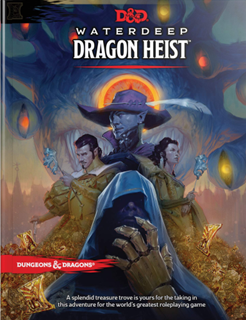 In just over a week, I’m going to start running Waterdeep: Dragon Heist as part of our regular D&D Adventurers League play at our local store.
In just over a week, I’m going to start running Waterdeep: Dragon Heist as part of our regular D&D Adventurers League play at our local store.
We’ll begin with a Session 0, where the players create their characters and I can set the ground rules of the campaign.
I also have to make a few decisions of my own. The primary one is this: Which villain do I use?
It’s a good question. The answer will be guided by which villain I think I’ll have the most fun role-playing!
It’s my opinion that a lot of the fun of Dragon Heist will come from the interactions of the adventurers with the villain. If you, as the DM, can make that character memorable, then you’ve gone a long way to making the adventure memorable as well. There’s one villain in Waterdeep that I’m more familiar with than the others, and so I’m very likely to use that one.
You do want to consider if the villain will be a good fit for the players. It’s no use having one they won’t appreciate. However, it’s no good choosing a villain that you can’t play well! The entire adventure suffers as a result.
Adventure writers can help you understand the villain by using the character in several scenes, thus giving you information on his motivations and methods. The trick is to present situations where the PCs don’t kill them! Having a villain turn up several times also helps the PCs form an attachment with them. (Even if it is “I hate you!”. Perhaps, especially!)
It’s also possible to learn more about the villain by meeting NPCs who have been affected by the villain’s actions. The players and DM get to experience the villain by learning of their effect on the world. However, the characterisation of the main villain often suffers that way. Actually talking to the villain? That’s pretty awesome!
You can see various approaches to this in previous adventures. Curse of Strahd not only has the world reflect the actions of the villain, but the DM can have Strahd meet the party several times before the final confrontation. You can give real depth to Strahd, and allow the players to feel they’ve accomplished something when they finally confront him at the adventure’s climax.
Compare this approach to that of Princes of the Apocalypse. In that adventure, the four villains have developed backstories, and the actions of the cults have a decided effect on the world, but you rarely interact with the leaders before you defeat them. I found it very difficult to give the leaders any personality. They ended up just being used in boss fights!
Part of the handling of an adventure’s villains is in the DM’s hands. It’s very easy for DMs to run lairs as a static place, with the villain waiting in the final room. That’s been a flaw of Lost Mine of Phandelver each time I’ve run it. The foes should be acting in response to the players’ actions and not just waiting for them to turn up! It’s part of my DMing I need to work on.
It helps when the adventure designer includes notes for how the villains react to their lair being invaded. Do they hole up and prepare defenses? Do they send minions to harass the PCs? Do they come out and force a confrontation when the PCs are unaware? I’ve got this concept of the PCs barging into a room, finding the villain waiting for them, who then proceeds to berate them for their lack of manners! If the designer covers that in a paragraph or two of text, it makes it easier to run.
D&D (and many RPGs) have a problem with villains: It’s easy for the PCs to kill them without consequence. This means that running a recurring villain can be very difficult. When you have a strong law in the city – such as in Waterdeep: Dragon Heist – that frowns on that – then things get interesting. I’m excited to explore that in this campaign.
However, this won’t work at all if the players don’t understand that the parameters of the campaign have changed. So, in the Session 0, I’ll make it clear to them that there is are laws in Waterdeep, and characters who break them will be punished. I may need to send a character to prison before it sinks in, of course.
As part of the process of choosing the villain, and seeing how well I can role-play them, I’m looking through Dragon Heist to see how much they appear, and how much aid there is for portraying them. If you’re about to run this adventure, I think that’s something that you should consider as well.

Kudos if you don’t just default to Xanathar, although lots of players may have never fought a beholder before. I’m really excited about this storyline as they’ve needed a good urban campaign forever it seems. I’ll be interested in whom you end up choosing if you don’t announce it publically.
Sooooo… Which villain did you choose?! 🙂
I knew I’d be starting the story on a particular in-campaign date to line up with events occurring in two other campaigns of mine (one concurrent, one just finished): the 30th of Tarsakh, the day before Greengrass; Spring. All of the villains and their stories are fantastic, but I was delighted to have landed on Xanathar.
I’ll let you know in a few weeks!